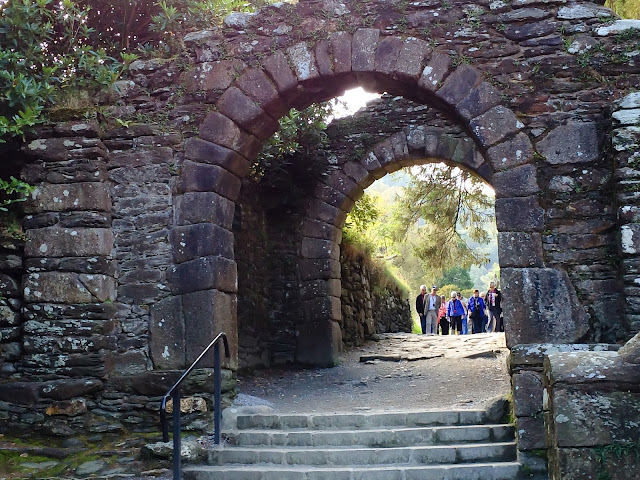IRELAND #8: BRÚ NA BÓINNE AND GLENDALOUGH
Two of Ireland's most interesting historic sites lie a short distance from Dublin. Brú na Bóinne, which means "mansion (or high ground) of the Boyne" to the north of Dublin, is a historically important complex of megalithic sites dating from the Neolithic period. Glendalough, to the south of Dublin, is the site of a medieval monastery founded in the 6th century by St. Kevin.
Newgrange is one of three important megalithic sites at Brú Na Bóinne. On our walk to the site, we discovered that we were walking over the Boyne River, not far from where the Battle of the Boyne was fought in July of 1690. On that fateful day, the Protestant King William defeated the Catholic King James.

Newgrange is a passage grave that was built around 5000 years ago.
When Newgrange was excavated in the 1960"s, archaeologists discovered that on the winter solstice (and only on that day), rays of the sun enter the tomb and light up the burial chamber for a few minutes.
The passage and the chamber in the tomb the tomb are 24 metres long. The small opening above the lintel was designed to allow light into the tomb only once and on the day when daylight begins to grow longer (December 21).

It appears that Newgrange was conceived to celebrate the annual renewal of life on December 21 when the sun stops moving south in the sky and begins to move back north. The lighting of the interior of the tomb was seen to be a union of the Sun and the Earth.

The Entrance stone, with its combination of spiral and lozenge shapes, is recognized as one of the greatest pieces of art of the Neolithic Age.
The carvings were made in the stone with stone tools! The builders had no metals. There are 75 decorated stones at Newgrange. There is more carved art in Brú Na Bóinne than in the whole of Western Europe combined (600 stones).
These carvings on this kerbstone include circles, spirals, arcs, and chevrons.
The structure has been waterproof for 5,000 years!
After leaving Newgrange, our group visited a family who have dedicated themselves to teaching others the traditional way of life of many Irish people in this area.
Here we are learning how to bake soda bread.
We were told that the sheep dog is still learning his trade!
Sandi holds a newborn puppy.
The Connemara horses wanted to make friends.
Dessert was scrumptious!
On our final full day in Ireland, we visited one of the most picturesque monastic sites imaginable. It is named Glendalough, which means "Valley of the Two Lakes".
The Glendalough monastery was founded by St. Kevin in the 6th century. It was sacked by the Vikings and later razed by English forces. Most of the buildings date from the 10th to 12th centuries.
The Round Tower, built for defensive purposes, reaches 100 feet in height.
The Cathedral dates from the 10th and 13th centuries.
This building is known as St. Kevin's Kitchen, and was likely erected in the 11th century.
Steve appears to be contemplating the mystery of it all!

























































